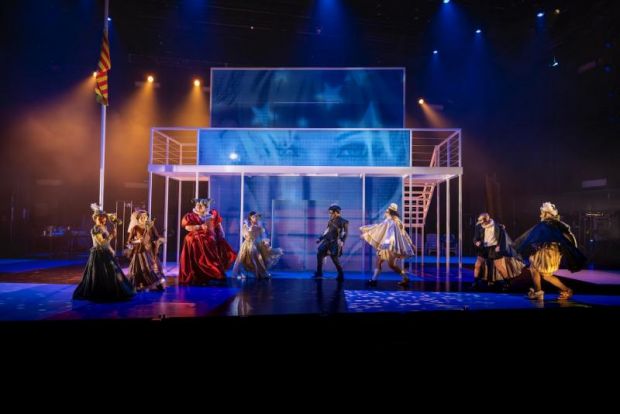Much Ado About Nothing
Director Mark Wilson presents a vision of this play that pushes the boundaries of its humour by accentuating the visual and physical gags inherent in the text frequently beyond their usual limits. This produces a play which is full of rollicking fun, non-stop laughter with a very satirical perspective. Wilson provides a very unconventional interpretation of the play and works through both the romance and the comedy with unrelenting boldness.
The set design (Anna Cordingley) exudes minimalism and transparency which conveys a decidedly postmodern attitude. Leonato’s residence is imagined as a recognisable Melbourne beachside residence by taking inspiration from St Kilda’s iconic Newman House. The set points to a lavish lifestyle but the entire artifice of theatre is exposed accentuating the level of contrivance in the society of this play. Revealing the backstage machinations emphasises the textual intrigue and especially highlights the extraordinarily clever doubling of roles in this production. The costume (Karine Larché), lighting (Katie Sfetkidis), and sound (Joe Paradise Lui) design are equally unafraid to be explicit in their support of both the humour and the drama creating some extremely striking visual effects.

The cast provide a style of performance that echoes this postmodern attitude, where a tongue-in-cheek attitude sits very comfortably alongside the serious drama inherent in the play. The gender war that is waged in this production is laid out as a continuous battleground where women ultimately get the upper hand, despite all the societal privileges afforded to men.
The fundamental and pivotal relationship between Benedick (Fayssal Bazzi) and Beatrice (Alison Bell) is kept at the forefront of this production as they process their own feelings and the discriminatory attitudes that fuel their ambivalence towards each other, and to the notions of love and romance. This allows both the drama and the humour to operate alongside each other in a very smooth and seamless manner.

In a further deconstruction of the theatrical mode the performers often cast their gaze directly at the audience and make a connection that is akin to a meeting of minds. Chanella Macri (Margaret/Bastard) is frequently exceptional at this kind of gesture. Julie Forsyth (Ursula/Dogberry) is phenomenal in the way she provides compelling and masterful examples of an ability to toy with her audience. Forsyth literally sets the tone for the play which unifies the entire ensemble into a very cohesive vision.
Miela Anich (Hero/Borachio) displays enormous versatility in her roles, Syd Brisbane (Leonato) accentuates both the endearing and annoying aspects of his character. Remy Heremaia (Claudio) and John Shearman (Prince) are both perfectly cast as the victims of the farcical societal demands they often unwittingly peddle.

This is a production that brings both a sharp eye and a depth of thought to the play that renders it as much more than a facetious examination of social structures which often result in prejudice and, ultimately, irreparable injustice.
Patricia Di Risio
Subscribe to our E-Newsletter, buy our latest print edition or find a Performing Arts book at Book Nook.

